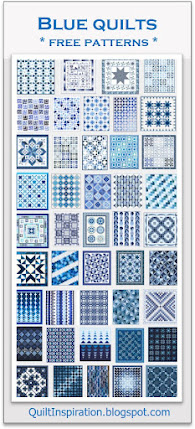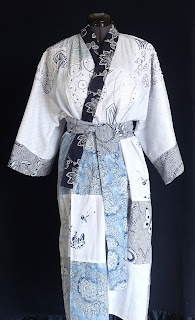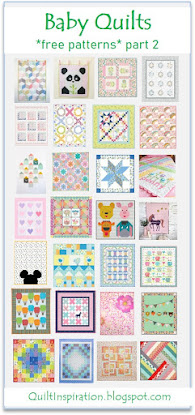The Connecting Our Natural Worlds exhibit by SAQA showcases art quilts that
illustrate the natural wonder of habitats around the globe.
Through their own unique artistic interpretation, each artist has
identified danger to flora and fauna in their own backyards. The selected pieces inspire viewers to get closer to nature and
become better stewards for our environment. We recently visited this outstanding exhibit at the Brigham City Museum in Utah.
~ p.s. Check out our eBay shop for great bargains on books, magazines, and collectible items. For free quilt patterns, please visit us on Twitter.
Treelines by Deborah Boschert, Texas
Deborah's creative, pretty quilt shows the importance of the growth cycle of trees, as it relates to water and weather, as shown by the gently painted raindrops here. Her techniques include fused applique, surface designs, paint, free-motion quilting, and hand embroidery
Vanishing Sanctuary by Holly L. Cole, Virginia
Holly writes, "Habitat loss for trees and wild animals is an escalating problem in the ongoing urban sprawl of Washington, D.C. into northern Virginia where I live. The woods surrounding my house offer sanctuary for me and many creatures. Fall foliage provided both inspiration for the imagery and the leaves for printing this quilt."
Holly adds, "Sadly, new condominiums are quickly eliminating my neighboring woods. Using the model set by the Nature Conservancy, our best defense against habitat loss is to purchase and nurture the land and participate in local, public, re-zoning meetings to raise concerns.
Holly's lovely quilt in vibrant colors is enhanced by her use of silk organza, whose delicate transparency is symbolic of our fragile eco-system. Holly also used skeleton leaves, screen printing, free motion quilting, applique, and Pojagi-style construction with covered seams in her patchwork.
Protected Finch by Maria Billings, California
Maria states, " Every year, finches migrate through my back yard, seeking shelter under the cover of green leaves. The "leaves" in this piece are shown as over 200 individually dyed and sewn folder rectangles that overlap. Like in nature, where no two leaves identical, these rectangles vary in material, size, and color. Some species of finch are endangered, others less so' but all of them require our protection and care."
House Home Hive Habitat by Linda M. Kim, Texas
Linda notes, "Some years back, I replaced a large swath of lawn with native plants and learned to garden. I was thrilled with the abundance of new wildlife. Blooming flowers drew bees, butterflies, and hummingbirds."
Linda continues, "This abstract house represent the bees' habitat as well as the home shared by all creatures on earth. An hourglass on the door links to the dire warning, ' If the bee disappeared off the surface of the globe, humans would have only four years to live."
Image credits: Photos were taken by Quilt Inspiration at the Brigham City Museum in Utah. As of August 2021, many of the pieces can be purchased at the Connecting Our Natural Worlds web page.
























This is what I love about quilts the most . . . like blades of grass, no two are exactly alike. That's why I never get tired of seeing new and old quilts, they are all works of art that can stand alone and reminders of a lost art that is truly having a revival.
ReplyDeleteHappy Quilting!!!
Connie :)
These pieces really speak to me. My children all work to preserve nature. Son fighting forest fires in the northwest, daughter working with urban forestry, another daughter in Boston starting urban forestry there and even in Japan community activities, and another son doing community art.
ReplyDelete